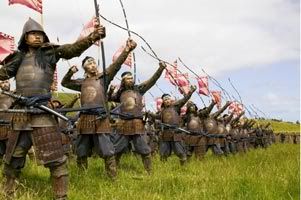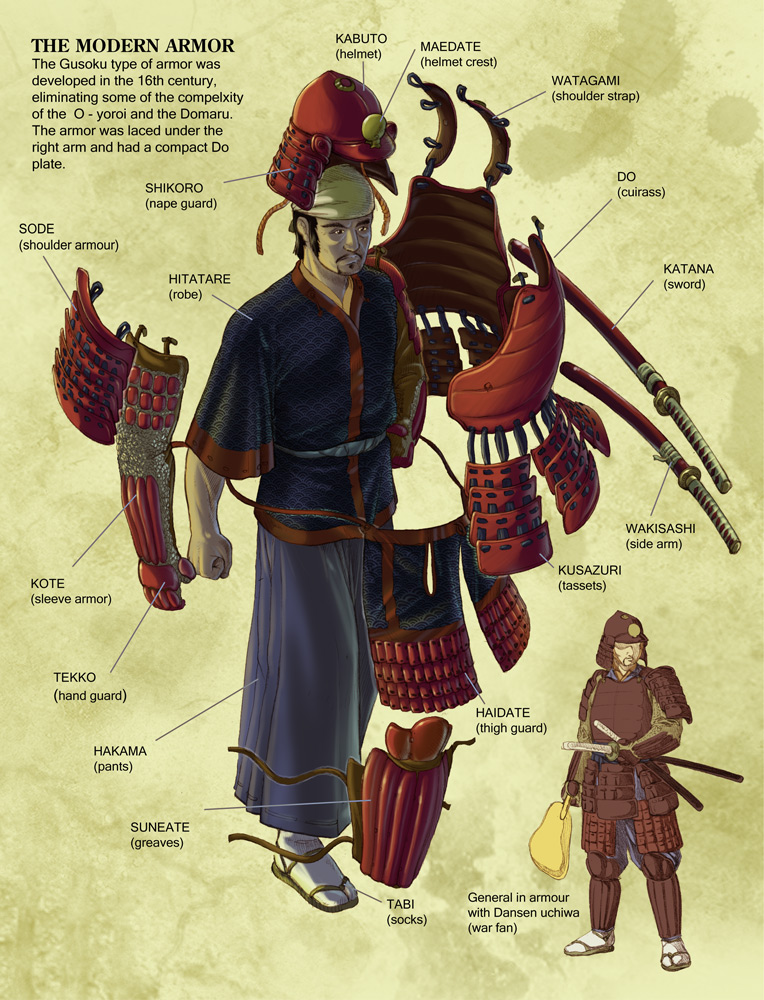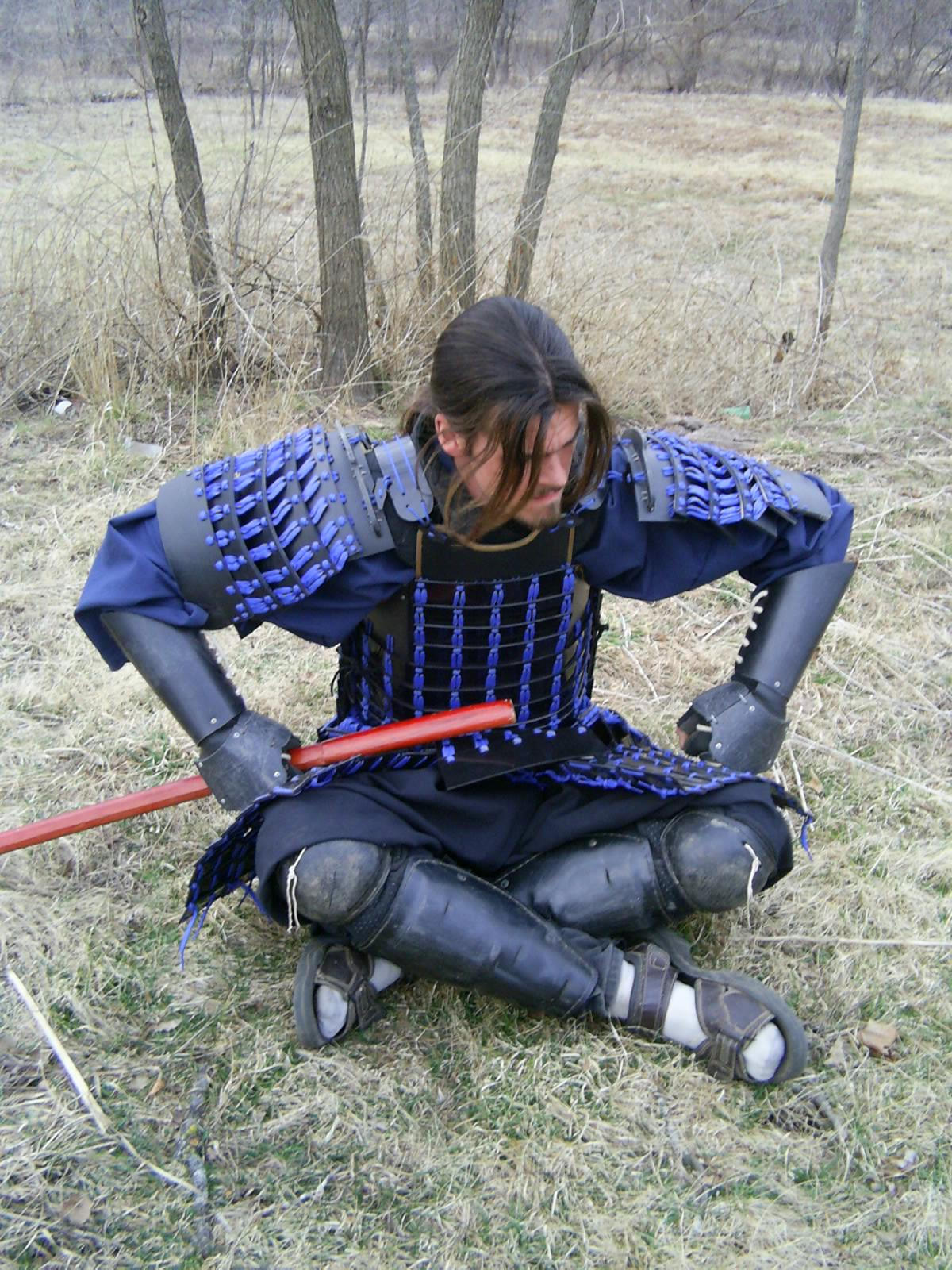Author's Note: The warrior-cultures of the Eastern Hemisphere really are not my forte, so if you see an error here or there please point it out to me and I'll do my best correct it (provided that I can find a source or two to back up your claim).
 |
| This photograph of several samurai warriors, two retainers flanking their daimyo, gives an excellent representation of the arms and armor used at this time period. From left to right: a yumi, katana and naginata can all be easily seen. The image is used without permission from http://exequy.files.wordpress.com/. |
-Offensive Assessment
~Close-Quarters Combat; Wakizashi. The wakizashi was the second-smallest of the three swords worn by every samurai, along with the katana (largest) and tanto (smallest). Many in today's culture believe that it only existed to be used on the samurai that owned it in an act of seppuku, but that is only partly true. Whenever a samurai would enter indoors he would leave his katana at the door as a sign of respect towards the homeowner, but would bring his wakizashi with him in case a situation would arise when he would need it. The wakizashi was used basically as a shortened katana, but was capable of being used to thrust as well as slash. It is believed that the ninjato sword made popular black-clad ninja was created by attaching a wakizashi blade to a katana handle, allowing the user to draw the weapon faster and surprise opponents. Given its short length but multiple functions, I'll give the wakizashi a three (3) out of five (5).
-Weapons of Reach; Naginata, Yari. The naginata was a slashing polearm, typically seven to eight feet long. The yari was a longer, thrusting polearm from six to twelve feet in length. Both weapons were superb at what they did, and had fighting styles devoted to their understanding and use. In later periods the naginata would become a weapon used by samurai devoted to the martial art of its use and a household defense weapon expected to be used by women. In contrast, the simple yari became a soldier’s tool, used en masse by the ashigaru foot soldiers in order to support the individual samurai in combat not unlike European pike blocks. Together, I'll give these two polearms a score of nine (9) out of possible ten (10) points, as they possess great reach and damaging potential but have the downside of a large “dead zone” – the length of empty space between the user and the blade, through which an enemy could cross unopposed.
 |
| This image demonstrates how the yumi would have likely been employed in mass battles - not much unlike how the Welsh-English longbow was used. Massed ranks of professional archers would have lined up, much like this, and loosed clouds of arching, steel-tipped darts upon the enemy. The image is used without permission from http://i19.photobucket.com/. |
-Long-Distance Fighting; Yumi. The yumi was actually the first weapon of the samurai class, dating back to their origin as horse-mounted archers. Despite the sword coming into an unprecedented vogue, it was maintained throughout their history as a martial and spiritual art. Many samurai would open a pitched battle with a volley of arrows from their yumi before closing into melee combat, so as to disable as many of the lower-class soldiers as possible and therefore not have to use their sword on them. Yumi longbows were expertly crafted and accurate, possessed great range, and decent penetration power. All of these qualities in mind, I'm awarding the yumi a score of nineteen (19) out of twenty (20) possible points. Though very accurate and able to loose multiple arrows in short amounts of time, the actual penetration ability and lethality of the yumi’s darts leaves some wanting.
-Specialized Weapons; Katana, Kanabo. The katana: the most famous weapon of the samurai. The katana was a sword between two and three feet in length, fashioned of the highest-quality steel and unique to each samurai and swordmaker. The katana was made to be a primarily slashing weapon, as it was customary to remove the head of defeated enemies, so this naturally made that easier. Only members born into the samurai class could own or use a katana, or even touch one - and only their own. This strict rule was but one of many used to oppress the lower classes of feudal Japan. The kanabo was typically an all-iron or wood war-club that weighed in at eleven pounds and was almost four feet in length. It would be used with both hands, and only by the strongest and most skilled of samurai. There would be many rows of raised iron studs embedded in all sides of the kanabo, so that however it hit it would deliver a likely-lethal blow. Decorative kanabo of wood and iron were created for display use, and the weapon itself is today associated with the mythological oni. Due to the highly-lethal nature of both of these two-handed weapons, but fatigue-inducing attributes of them both, I'm going to give these weapons four (4) out of five (5) possible points. Additionally, neither weapon is able to be used with a shield, further hurting the warrior rather than helping them.
 |
| This image presents a great cutaway of the layers and composition of a panoply of samurai armor. The layers of silk, leather and plate come together to create something far greater than the sum of its parts. The image is used without permission from http://fc03.deviantart.net/. |
-Defensive Assessment
~Head; Kabuto. A full panoply of samurai armour included the kabuto, a wide-sweeping helmet that provided good protection to the neck and sides of the face. The kabuto was designed to fulfill two purposes: to protect and to be seen. Samurai would have their helmets emblazoned with large metal crescents, bull's horns, deer antlers, and other decorations in attempts at being unique. The kabuto worn by ashigaru were far less decorative, and were worn closer to the face than those used by the samurai. Unfortunately, the kabuto left the face open to attacks and obscured the ears, limiting the senses. It could be argued that the face-covering worn by some samurai to intimidate their enemies would help on defense, but it wasn't composed of any material stern enough to withhold a blow of significant force. Furthermore, the kabuto would be vulnerable to attacks coming from underneath or to the sides – it was shaped to primarily protect the back of the head. With all of this in mind, I award the kabuto helmet seventeen (17) out of twenty (20) points, as despite its shortcomings it performed excellently against the majority of strikes to the user.
~Torso; Do, Kusazuri and Haidate. The armour that covered the torso, back and shoulders of samurai and ashigaru was originally composed of solid plates but later shifted to small, lamellar scales sewn on silk to get a more flexible, stronger product. This gave them a great defense against both piercing and slashing attacks, and covered most of the vital chest relatively well. It was typically painted in vibrant colours, for the same reasons as for the kabuto. Naturally the armor worn by samurai would have been more ornate than that worn by the ashigaru. There was great variety in body armor than is normally portrayed beyond the scope of lacquered plates; armor made wholly of silk or leather, or even chain-maille has been discovered. Overall, the torso defenses of the samurai net an eight (8) out of ten (10), as they were not the most flexible of materials and were very susceptible to less orthodox attacks such as could be found from blunt-force weapons.
 |
| This is a modern recreation of period-accurate samurai armor. Like the other images, it showcases the strength and stability of the panoply. The image is used without permission from http://fc09.deviantart.net/. |
~Limbs; Sode, Kote, Tekko and Suneate. The armour that protected the extremities of the samurai and ashigaru was made of whatever materials that the torso armour was made of. It was typically light, easy-to-move-in armour over thick clothing made of silk or linen. Together, these elements earn a score of three (3) out of five (5).
~Blocking; Parrying, Reach. The easiest way for a samurai to defeat his opponent was to outdistance them. They accomplished this by using weapons of great reach - long-distance bow-and-arrows, tall polearms, and long-bladed swords. Whenever an enemy got within their killing-radius, they would then rely on their ability to redirect attacks, either parrying them or outright dodging them. However, they had no true blocking defenses, and so only get a middle-of-the-pack score of three (3) of five (5).
 |
| Toyotomi Hideyoshi is considered by many to have been the first true Emperor of a unified Japan; formerly a retainer to the infamous daimyo Oda Nobunaga, Hideyoshi succeeded his liege-lord following his death to become one of Japan's most revered historical figures, military or otherwise. This image is used without permission from http://wigwags.files.wordpress.com/. |
-Variables Assessment
~Tactics; until the later time when massed armies of ashigaru were common, warfare in feudal Japan consisted largely of traditional, individual combat. The nobility would single one another out and open engagements with precisely-aimed arrows; once those had been expended they would then seek out an opponent of equal or greater status and duel them. What formations that did exist were largely intended to keep the commoners from interfering with the elite during combat, such as irregular, messy pike blocks. The tactics of the samurai get a below-average two (2) points.
~Morale; the samurai would be inspired to fight by many forces – political machinations, familial ties, personal honor quests, and more – and so the motivation to stay on campaign and in the face of death differed from individual to individual. That said, the honor-code of bushido that all samurai adhered to stipulated that to show a lack of courage in battle was punishable by assisted suicide. Many samurai stuck to that belief, but it is not immediately clear how many obeyed it to the letter. They are awarded four (4) points out of five (5) for this category.
 |
| Despite the stiffest of resistance to Western ideas and culture, over time Japanese warfare became a confusing amalgam of Western and Eastern methods, with primitive handguns being a common site on battlefields all across Japan. One of the first Japanese leaders to use this new military technology effectively was Oda Nobunaga, a man also known for his love of castle-burnings following a battlefield incident concerning his taking of an arrow to the throat. This image is used without permission from http://factsanddetails.com/. |
~Training; all Japanese warriors were intensely trained from the moment they were chosen to be fighters – in the case of the daimyo, not far from birth – in multiple martial arts forms. They treated the act of using the yumi as if it were an art form; there are still several schools of spear-fighting remaining today, and the way of the sword has proven immortal. It’s easy enough to give them a score of all five (5) possible points in this category.
~Innovation; the samurai were unique in that they created a great warrior-culture from a small amount of available resources. As such, what gear they used and how they used it was at a very high level of quality. They fought rather efficiently and against the norm by using two-handed weapons, and for all of that they get four (4) out of five (5) points.
Excellant Bio! Really spot on about the samurai. Some things about the Yumi: Yes, they were deployed in mass ranks like Anglo-Welsh long bowmen, but unlike them, they fired at individual targets oppose to firing in a mass volley. When the Mongols invaded Japan, the samurai saw hit and run, fire in volley tactics of their eastern neighbours has barbaric and cowardly.
ReplyDeleteThe samurai would have different armour for different situations. While mounted on horseback, which they were for most battles, they would wear o-yoroi armour (great armour), which was heavy and thick to defend against yaris and arrows.
Lighter armour was developed for foot based samurai, who would probably be guards or support troops in battle. Kozane armour was made up of scales and used from the samurais beginning to the late Edo period has a cheap form of armour. Tosei-gusoku was made of heavier but strong steel plates, and this is the type of armour your daimyo would use. The samurai also used jack of plates type armour and budded chainmail in rare cases.
Sword fighting on the battlefield was a tactic more of last resort, as yaris and yumis would be more the deciding weapons. Samurai didn't have the same katana forms in 1600 as there are today. The samurai is truly a romanced warrior of our times, much like a medieval knight. Note that the knight and samurai were both heavy mounted warriors, and would not fight hand to hand on the ground regularly.
@MM; thanks for replying, that's exactly the sort of response that I was hoping for. That's an interesting point about the yumi - I'd think that individual fire would be more efficient than massed volleys.
ReplyDeleteI'm guessing that the different armor types would have depended on the personal wealth of the samurai as well as their "unit" type? Ie, a wealthy daimyo would fight from horseback with that o-yoroi armor that you described while one of his noble-born retainers (likely a nephew or somesuch) would use that kozane scale-maille and the progressively poorer classes of ashigaru would have simple leather lamellar with some steel plate elements? Also, am I correct in guessing that chain-maille would have not been a very popular occurrence among them?
Lastly, what period would you say that I should specify my daimyo and his retainers as hailing from? I originally picked 1600 CE out of a hat as I thought that it was a time when gunpowder weapons were not very widespread and armor was highly developed, but recent research on my part has proven the former point to be incorrect. What would be a more accurate year?
The yumi was used in mass volleys, just with a bit more accurate combated to the english longbow. It was also very effective on horseback.
ReplyDeleteAccording to my sources, the o-yoroi was used up to the 14 century, when ground based combat increased. A daimyo would probably still wear a suit of it, but one a little lighter, more like an ungraded kozane.
The best time period would be around 1500, as this was when the o-yoroi, yumi, naginata, and katana were still popular amongst the samurai. This was also just before the introduction of gun powder, which really brought an end to traditional Japanese feudalism.
Yes, Japanese chain mail was very rare, and rarely saw any battlefield use. It was used, however, but scouts and spies as a type of very light body armour, which would be effective against most swords of the time.
If you do write a battle between the Norse and the Samurai, you should consider that samurai were nearly always mounted, like European Knights. just as well, the Norse were know to deploy shield walls very effectively against mounted opponents, but I don't suppose they would be prepared for the armour of the samurai.
Either way, both warrior bios are very accurate and fun to read. The Norse would probaly come on top just because of the defensive abilities of their shields, which would save them at nearly all ranges.
P.S. The kanabo, or tetsubo, was never used for combat through out Japanese history. Blunt force weapons were frowned upon as barbaric. It's funny, because the Japanese copied the use of horse archery and curved swords from the Emishi, the northern people who were though as savages.
The samurai actually did use formations, or rather medieval Japanese armies did as a whole. A google search reveals a few forum posts and websites.
ReplyDeletehttp://warandgame.com/2008/04/18/samurai-battle-tactics/
http://www.kendo-world.com/forum/showthread.php/17700-Use-of-formations-in-Samurai-battle-tactics?s=c651cec6c67bc51094eac578f95d1a8a
http://www.totalwars.ru/encyclopedia/how_to_play/050a_enc_manual_battle_conflict_formations_land.html (if a major video game is an acceptable source)
There are also books by Stephen Turnbull on Japanese warfare.